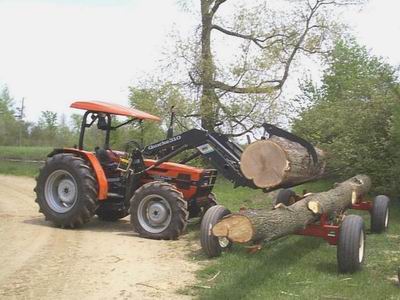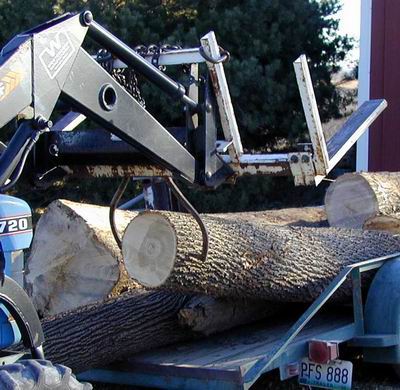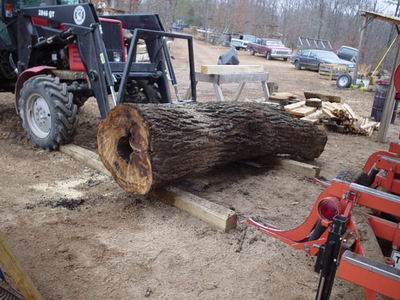How to move logs
Creative and practical ways of loading, unloading and transporting logs. Illustrated. (Sawing and Drying Forum) March 23, 2003
Question
When you buy logs, how do you move them? If they are delivered by the tractor trailer load, do you have the equipment to unload the tractor trailer? What does it take to unload them? Can you go to your log yard and just pick up a couple of logs? Will they load them or do you have a forwarding trailer to carry them?
Forum Responses
(From WOODWEB's Sawing and Drying Forum)
I use an old hydraulic self-loader mounted on a truck for unloading and sorting logs.
I use a grapple skidder to move the logs to the mill. I can lift the logs clear off the ground so I can move them over gravel areas without getting rocks in them.
The other day a guy brought out some logs on his car hauler. We hooked a chain on the log and tree and he couldn't pull it off because he kept spinning his tires. So I hooked DD on them and pulled them right off.
I use a skid steer loader for most log handling. I want a knuckle boom to unload trailers, and it would be great for loading a log deck. It would be faster than a skid steer but not as versatile. I use a gooseneck tailor to haul logs and a gooseneck with a flat dump bed to deliver lumber. For larger loads I contract the hauling.
A log yard that merchandises logs (buys them from small loggers and resells them) would probably be glad to sell you logs. I don't know how affordable it would be, though. If they are unloading logs they have a way to load you.
For a small startup mill you need to be able to capitalize on the free or nearly free logs that most operations overlook. The trees cut from right of ways and from construction sites are a good place to start.
I have a JD 5300 with a 740 loader that I use for small loads of logs that may appear here in pickups, on small trailers, etc. For large quantities I will have the logs brought in by self loader trucks. That's usually about 3,500 bd ft (log scale) per load. I just had 3 17' 32" Douglas firs brought in yesterday and the single axle farm truck simply dumped them right in front of the mill building for me. Each of them weighs in excess of 4,000 lbs., but I can handle an end at a time with a 32" logging tong. I have maneuvered some 6' sequoia in 9' lengths.
Here's my skidder, loader, unloader, and about everything else around my mill.

I use tongs on trailers with sides on them. I hang the tongs from the loader frame so they won't twist so I only have to get off the tractor to unhook. On my gooseneck, wagons, and 10 wheelers I use the log forks and pray that the log isn't heavier than my tractor.
A note on tongs - they are just like any other tool - the points have to be *sharp* before they will work.

Some by hand but most with a tractor with loader. Would love a small knuckle boom loader. On large pole trucks I have just taken some timber tongs mounted on the forks of the loader and lifted while pulling off the back. There are several loggers who will load my trailer and sell me logs in the woods. Anyway, any how so long as it is safe.

I have a Ford 3930 tractor - bought a boom pole, a chain and lifting tongs to skid them with. Works well except on the larger than 30" logs - the front wheels come off the ground.
I get a lot of logs out of yards. We used a Hudson trailer to go get them. For years loaded it by hand or wrapped a chain around it and used my Jeep to pull them up skids laid across the side. When we got home we would role them off the side and skid them up to the mill with an old 135 Massy Ferguson. Then we lucked up on an old 340 Ford tractor set up for logging. We now unload with its forks, and on the big ones it turns around and winch it off. Our last (bought it Saturday) addition to our collection is an old L series Ford flat bed which we plan on installing a crane on as time/money permits. We also buy logs from larger mills or directly from the logger as they are skidded out of the woods. Both are happy to load us up.
The comments below were added after this Forum discussion was archived as a Knowledge Base article (add your comment).
Comment from contributor A:
I use an electric winch to load logs onto a trailor. In the old days, they used horses to roll the logs up on ramps. I do the same with a battery powered winch. I follow the same principles that were utilized to load the World's Fair load a hundred years ago. It is slow, but I can load one log cord onto the trailor in about 1 hour if the logs are all big (18-25 diameter). To get them onto the wood deck I reverse the process with the hand crank on the sawmill. It's slow but the only cost besides the initial investment is my time. It has been very safe, because when I'm working the winch I'm not near the log. I'd love to have a front end loader, but I can't afford it. For under 2500 dollars worth of modifications I have a self-loading, multi-function trailor which has moved over 50 MBF of logs.
Comment from contributor W:
Regarding logging with farm tractors, do not operate without ROP and canopy. Currently using a Ford 6610 with a Fransguard winch. Cable is 200 feet and does have tremendous value in some commercial and urban forestry applications. Overloading winch and lighter equipment is a risk that users must be more aware of during use in forestry applications. Intermediate felling and hinging training is invaluable in placement of timber for efficient cabling, skidding and handling of timber and logs. Overloading increases equipment damage and risk to operator. Be wary of trailors that can be overloaded when hauling with light equipment (tractors and ATVs). Without sufficient trailor brakes, you may be going for the ride of your life.


